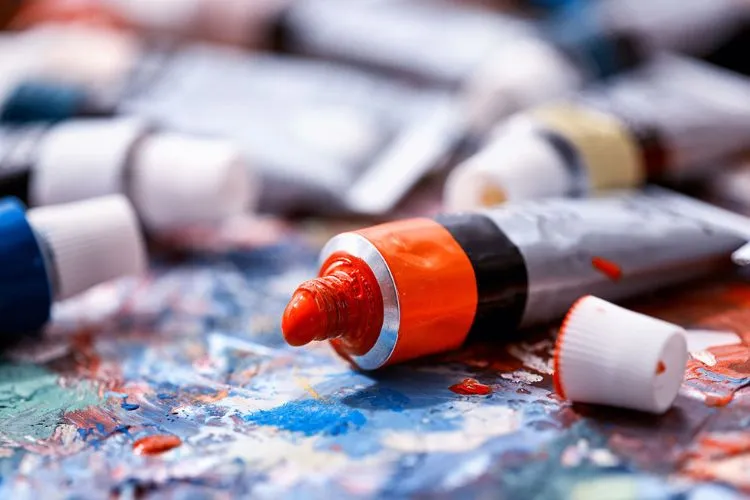Acrylic paint is known for its versatility, vibrant colors, and quick drying times, making it a favored medium in the art world. However, like any other art material, it has a finite lifespan, which varies based on whether the paint is factory-sealed or has been opened.
This article delves into how long does acrylic paint last, offering insights into maximizing its shelf life.

Understanding Acrylic Paint
Acrylic paint comprises pigments for color, an acrylic polymer emulsion that binds the pigments, and additives to enhance various properties like drying time and consistency.
When acrylic paint dries, the water in the emulsion evaporates, leaving a durable, colored film. This drying process is central to the paint’s longevity, both in the jar and on the canvas.
How Long Does Acrylic Paint Last?
Factory-Sealed Acrylic Paint
Unopened acrylic paint typically lasts 5 to 10 years, if not longer, when stored under ideal conditions. Factors that affect this shelf life include temperature, humidity, and exposure to direct sunlight.
Paints stored in a cool, dry place away from sunlight are less likely to undergo chemical changes that could affect their usability. For best results, aim to store your paints at a consistent temperature away from extreme conditions.
Opened Acrylic Paint
Once opened, acrylic paint’s exposure to air starts a slow drying process, even when the lid is securely fastened. Signs that paint has gone bad include an off smell, a noticeable change in consistency, or separation of the components.
To extend the life of opened paint, ensure the lid is closed tightly after use and store it as you would unopened paint.
Acrylic Paint Application and Longevity
The method of application and the surface to which acrylic paint is applied can influence the paint’s drying time and the durability of the final work.
Using primers and varnishes can significantly extend the lifespan of the artwork by providing additional protection against environmental factors.

Common Issues and Solutions
Mold can develop in acrylic paint if it’s stored in overly humid conditions. If you detect mold, it’s best to discard the paint as it could pose health risks and affect the quality of your work.
Thickness or slight drying of paint doesn’t necessarily mean it’s unusable. Adding a small amount of water or an acrylic medium can often restore its workable condition.
However, such alterations might affect the drying time and finish, so proceed with caution.
Professional Insights
Professional artists often emphasize the importance of good storage practices. Many agree that while older paints can sometimes be revived or used in mixed-media projects, it’s vital to test such paints before applying them to significant works.
They also recommend investing in higher quality paints, as they tend to have better pigments and binders that might contribute to a longer shelf life.
Environmental Impact on Acrylic Paint
The environment plays a pivotal role in the longevity and usability of acrylic paints. Factors like temperature, humidity, and exposure to light can significantly influence the chemical stability of the paint.
High temperatures can hasten the drying process, even in sealed containers, leading to prematurely thickened or solidified paint. Conversely, excessive humidity fosters mold growth, compromising the paint’s integrity and potentially posing health risks.
Furthermore, direct sunlight or UV exposure can degrade the pigment over time, altering the paint’s color and consistency.
To mitigate these environmental effects, it is crucial to store paints in a controlled environment. A cool, dry place away from direct sunlight is ideal. Utilizing climate-controlled rooms or cabinets can help maintain an optimal temperature and humidity level.
Additionally, opaque containers can protect pigments from harmful UV rays. By taking these preventative measures, artists can preserve the quality of their acrylic paints, extending their shelf life and ensuring consistent results in their artwork.
You may also find useful: Does Acrylic Paint Fade In Sunlight?
Safety and Health Considerations
Safety and health considerations are paramount when dealing with expired or moldy acrylic paints.

Expired paints may contain harmful bacteria or fungi, which can become a health hazard, particularly for individuals with respiratory issues or weakened immune systems. Inhaling spores from moldy paint can lead to allergic reactions or more severe health problems.
To prevent exposure, always work in a well-ventilated area and consider wearing protective gear, such as masks or gloves, when handling suspect paints. If paint shows visible mold growth or an off smell, it’s safest to dispose of it.
Disposing of acrylic paint responsibly is also key to minimizing environmental impact. Never pour paint down drains or into water systems. Instead, let the paint fully dry out before discarding it in the trash.
For larger quantities or liquid paints, check with local waste management facilities for appropriate disposal guidelines, as some may offer hazardous waste collection services for art materials.
Frequently Asked Questions (FAQs)
Can you use expired acrylic paint?
If the paint is well preserved, it might still be usable, but always check for signs of spoilage.
How can you tell if acrylic paint has gone bad?
Bad paint might smell off, have a changed consistency, or show separation.
Is it possible to revive dried out acrylic paint?
Adding water or acrylic mediums can sometimes restore dried paint, but results can vary.
Do higher quality acrylic paints last longer?
Generally, yes, due to better ingredients and manufacturing processes.
How does the color of acrylic paint affect its shelf life?
Some pigments might degrade faster, but this is less about color and more about the chemical nature of the pigment.
Conclusion:
Acrylic paint’s longevity depends on many factors, including whether it’s been opened and how it’s stored. By understanding these factors and adopting best practices for storage and use, artists can ensure their acrylic paints remain viable for as long as possible.
Remember that while some tips can extend the life of your paints, it’s always best to inspect each paint for signs of degradation before use.
Let’s keep the conversation going. If you have any additional tips or experiences with acrylic paint longevity, share them in the comments.
Your insights could be valuable to fellow artists navigating the complexities of paint storage and longevity.

Meet Isabella Anderson, your acrylic painting mentor with over a decade of brush-wielding mastery. Dive into the colorful world of acrylics with her expert guidance, featured exclusively on ‘Acrylic Authority.’ Unleash your inner artist and explore the limitless possibilities of this versatile medium alongside a true acrylic aficionado.
